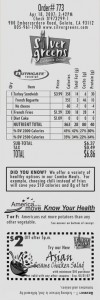
Brigitte Alarcon
“Should the world go on a diet in 2014?” asks a new report by the Overseas Development Institute (ODI). A cheeky question perhaps, but one that is worth asking in light of the negative impacts on the world’s natural resources and public health that result from over one third of all adults across the world being obese or overweight.
Worldwide, health organisations are valiantly leading the fight against obesity but with little success. Communicating messages that are clear, consistent and that resonate with consumers is a difficult task. Most importantly, knowledge does not always lead to action. No matter how well-aware we are of the negative impacts certain foods can have on our health or the environment, we are always able to disregard them for a variety of reasons. As such – and despite claims made by the weight-loss industry – changing behaviours to have a healthier lifestyle is a complex task which cannot be addressed through a ‘one size fits all’ solution.
LiveWell for LIFE has identified the key barriers that prevent European consumers from adopting healthy sustainable diets. These include amongst others: confusion around what constitutes a sustainable healthy diet; the costs – be they real or perceived – associated with such diets; existing habits, etc. For people to adopt healthy sustainable diets, these barriers ought to be removed. When it comes to clarifying what a healthy sustainable diet look like and to encourage people to adopt new habits, prompts that target specific behaviours can have a substantial impact [1].
In this regard, one tool has delivered surprising and positive results: a new technology. Nutricate allows restaurants and food providers to use receipts to deliver personalised nutrition information and education to their consumers. Receipts can feature a variety of information, such as the calorie content of the meal purchased or ‘did you know facts’. Receipts can also be used to recommend substituting certain foods for healthier options (e.g. choosing grilled chicken instead of fried chicken).
A November 2013 study published by the National Bureau of Economic Research entitled Making Nutritional Information Digestible: Effects of a Receipt-Based Intervention on Restaurant purchases looked at the impacts of using Nutricate at Burgerville, a restaurant chain in the Pacific Northwest. The study, which spanned over a period of 125 weeks and involved sales data from 39 Burgerville’s concluded that “customers, in the aggregate, made most of the item substitutions that were encouraged by the messages, such as substituting ham for sausage in a breakfast sandwich, or substituting frozen yogurt for ice cream, though effects on overall calories and fat consumed were small”. In simpler terms, although people were keen to substitute a side salad for fries, they might also choose other items that counteract the healthy substitutions made. Regardless, it was estimated that displaying nutritional information and recommendations resulted in a reduction in average cholesterol per transaction of 2.1 percent.
Through the use of personalised recommendations on receipts (in the sense that the message is triggered by the customer’s current purchase) and by going beyond the provision of information (and beyond reminding consumers of consequences they already know) by suggesting specific changes in behaviour, Nutricate demonstrates. One can only hope this concept soon makes its way to Europe.
Brigitte Alarcon
LiveWell Policy Officer – WWF-UK
References:
For the full report ‘Making nutritional information digestible: effects of a receipt-based intervention on restaurant purchases’ go to https://www.nber.org/papers/w19654.pdf
Full reference:
Making Nutritional Information Digestible: Effects of a Receipt-Based Intervention on Restaurant Purchases
Kelly Bedard and Peter J. Kuhn
NBER Working Paper No. 19654
November 2013
JEL No. C33,D03,D12,I12
[1] CBSM. 2011. Prompts: Remembering to Act [online]. Available at https://www.cbsm.com/pages/guide/prompts:-remembering-to-act/ [Accessed 8 January 2014].




